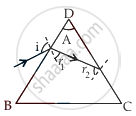Advertisements
Advertisements
प्रश्न
The maximum value of the index of refraction of a material of a prism which allows the passage of light through it when the refracting angle of the prism is A is ______.
विकल्प
`sqrt(1 + sin(A/2))`
`sqrt(1 + cos(A/2))`
`sqrt(1 + tan^2(A/2))`
`sqrt(1 + cot^2(A/2))`
उत्तर
The maximum value of the index of refraction of a material of a prism which allows the passage of light through it when the refracting angle of the prism is A is `underlinebb(sqrt(1 + cot^2(A/2)))`.
Explanation:

If the angle of incidence on face DC, or r2, is greater than the critical angle θC for the maximum angle of incidence (i1 = 90° = maximum) at face DB, a ray of light will not exit the prism for any value of the angle of incidence provided.
At DB, 1 × sin90° = μ sinr1
⇒ `r_1 = sin^-1(1/mu)`
or `r_1 = theta_C` .............(i)
For no emergence
r2 > θC ................(ii)
Adding equations (i) and (ii),
r1 + r2 > 2θC ...(iii)
Also r1 + r2 = A ...(iv)
We know that the sum of all angles in any triangle equals 180.
90 – r1 + 90 – r2 + A = 180
A = r1 + r2
Now, solving equations (iii) and (iv),
A > 2θC
⇒ `sin A/2 > sintheta_C`
µ > cosec `A/2`
As a result, the maximum value of
`mu = cosec A/2 = sqrt(1 + cot^2 A/2)`
